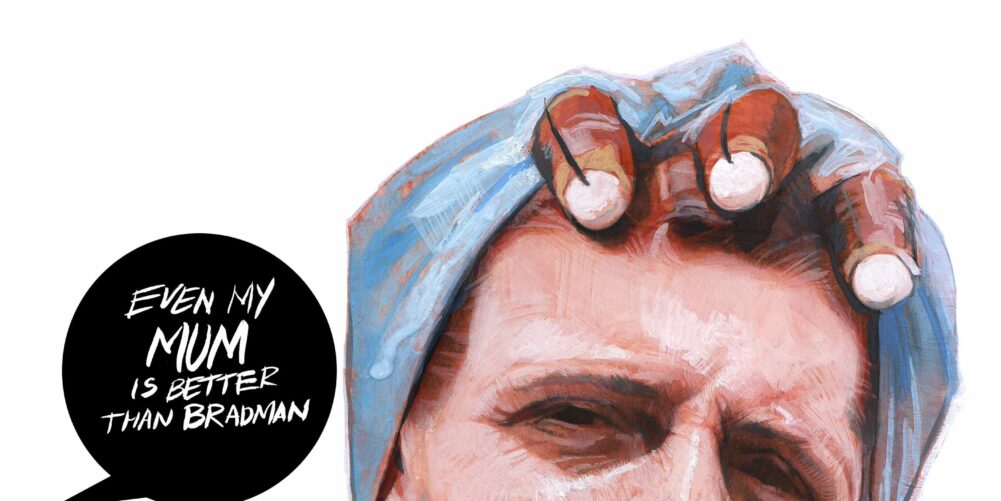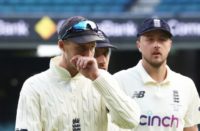There are one or two instances in which Wisden’s claim to be cricket’s unimpeachable bible fails to stand up to serious scrutiny, including the long since discredited notion that Sir Donald Bradman was the finest batsman who ever played the game.
Regular listeners to Test Match Special have no doubt at all that this particular accolade belongs to Geoffrey Boycott’s mum, who not only scored more runs than the Don, but also flayed the world’s finest bowlers to all parts whilst wearing a pinny and wielding a stick of rhubarb.
Unlike Bradman, she was also an all rounder, and while Geoffrey has been slightly less colourful in the analogy department when describing her bowling, we can perhaps take it as read that her bumper crop of ten-wicket hauls were all taken whilst running in on a pair of high heels and propelling a mango.
In which case, Sri Lanka’s batsmen can count themselves lucky that Mrs B has long since hung up the heels, and that they’ve only had to face bowlers as ordinary as Jimmy Anderson and Stuart Broad. On the Boycott scale of one-sided encounters, Jimmy could have run in wearing a Shirley Bassey evening gown, and bowled them out with something shiny from the greengrocers.
In fairness to Sri Lanka, they batted conspicuously better in their second innings in Durham, although my own theory for the improvement is that their coach suddenly had the brainwave of turning off the radiators in the visiting dressing room. Which made the urge to get back to the warmth of the pavilion as soon as possible slightly less attractive.
The Sri Lankans have had a bum rap when it comes to visiting England, traditionally getting early season invitations when the weather, in other parts of the world, involves having penguins for neighbours, and eating whale blubber for supper.
It all started on their first ever tour in 1984 (or the first in which they were awarded a Test) when their first port of call was, of all places, Cleethorpes. Not only did they spend that first week shivering, but half a dozen of them got laid up with food poisoning after an outing to a fish and chip emporium.
So while most of their batting on this tour so far has been pretty awful, there are excuses. Leading players have retired for one, and let’s face it, it’s hard to produce your full array of wristy strokeplay when your upper body is encased in a minimum of half a dozen sweaters.
For many of us, however, watching touring sides struggle against the likes of Anderson and Broad in early summer English conditions is something to celebrate rather than moan about – representing as it does the last chance to witness one of the great charms of Test match cricket.
Whenever I hear people banging on about the affect on the planet of vanishing forests and melting ice caps, I wonder why they don’t get half so worked up about the equally damaging blow to the ecology as the erosion of terrible batting. Once upon a time the life expectancy of a No.11 was the rough equivalent of a ribeye steak’s on Mike Gatting’s dinner plate, but nowadays it almost warrants a new series from David Attenborough of an endangered species teetering on the edge of extinction.
David Gower joined in the general sorrowful head shaking as Sky’s studio pundits ran through the highlights of Sri Lanka’s batting – forgetting, it would seem, that the grope at thin air, or limp prod to slip, has an entertainment value every bit as treasured as the sumptuous cover drive, and that when he was at Leicestershire, he was only the crowd’s (although at Grace Road it was more of a polite gathering than a crowd) second biggest batting attraction.
I can imagine a conversion from that era involving a Leicestershire member emerging from the dining room for a post prandial doze in the deckchair, and asking his next door neighbour not to wake him unless the team’s star batsman was on his way to the middle. “What, Gower?” “Gower? Don’t wake me up for Gower, for heaven’s sake. I mean Les Taylor.”
This was a man who not only made the two men sit up at Grace Road when he came into bat, but occasionally the dog as well. In fact Leicestershire were well off for crowd pleasing incompetents in those days, including Peter Such, who once wandered down for a midwicket chinwag with Jonathan Agnew after nicking a four, and proudly announced that the stroke had taken him past 100 runs. “What for the season?” inquired Aggers. “No” said Such, slightly put out. “Career.”
However, while the likes of Such were merely hopeless, what made Taylor so special was a complete absence of physical co-ordination. And this, plus the fact that he was weighed down by several kilograms of protective padding, would reduce fielders to hysterical giggling when Les, who didn’t much care for the short stuff, undertook evasive action. Imagine a hippo with all four legs tied together being attacked by a colony of hornets, and you’ll get the picture.
One of his finest moments came in a county game against Hampshire at Southampton, when an eyes-closed outside edge off Malcolm Marshall gave him the opportunity to get off strike. Off shot the Leicestershire No.11, but in mid pitch his bat somehow got caught between his legs, and the resultant explosion left him embedded in his own crater, and run out by several yards. The sight of which rendered Gordon Greenidge so helpless with mirth he had to be helped from the field.
Every side had its own Taylor. Not far down the M1 at Northampton, Jim Griffiths was a legend, averaging 3.33 in 138 career innings, including 51 ducks, ten of them in a row. Phil Tufnell liked a ciggy as did Les, and they could both leave one burning in the ashtray before leaving the pavilion, confident that there’d still be a puff or two left when they got back.
Not any more. No.11s are now expected not only to stay in, but score runs as well. Of the 26 century partnerships for the 10th wicket in Test matches, 12 have come in the 21st century. The loss of the genuine rabbit has somehow been overlooked in the debate over declining Test match audiences, and the remedy is actually quite simple. All the ICC needs to do is to create the new position of Tail Ender Batting Consultant, and appoint Devon Malcolm with immediate effect.
This piece originally featured in The Cricket Paper, Friday June 3 2016












